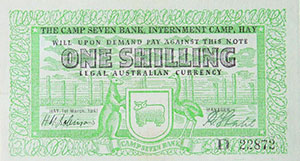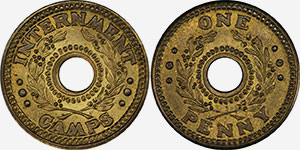The Dunrea Boys
By AG | Wednesday, 20 June 2012
The military transport ship 'H.M.S. Dunrea' was loaded with 2,542 so called 'enemy aliens' on 10 July, 1940 at Liverpool, England. Nearly all the passengers were political or racial internees, a majority of whom had fled to England from their homelands which had been occupied by Nazis and Facists. At that time, no chances of infiltration were being taken and they were treated as potential spies.
Almost two months later, the ship arrived in Melbourne where 545 'potentially dangerous' passengers were offloaded. The remainder continued the journey to Sydney from where they were transferred by rail to Hay in Central Western New South Wales. Here they were interned in two camps - numbers 7 and 8.
Notes dated 1st March, 1941 were issued at the Hay Internment Camp No. 7 for use by inmates mainly for purchases from the camp canteen. Three denominations - Two Shillings, Shilling and Sixpense - were printed, each with three separate signature combinations. The notes were designed by Austrian artist George Teltscher and printed by Harry Byers in the printshop of the Riverine Grazier, Hay. It is estimated that a total of 9,000 notes were printed (2,000 Two Shillings, 4,000 Shilling and 3,000 Sixpence). These issues contravened Australian law and were withdrawn in September, 1941. Many were cancelled with a red rubber stamp. The few notes that remain in existence - estimated at around twenty - are extremely rare souvenirs as all notes were supposedly destroyed.
The military ordered the closing of all civilian-based canteen operations and the task was taken over by the Australian Defence Canteen Service who, with the approval of the Australian Department of Army, issued five tokens for use in Internment Camps during World War II. The five shillings, two shillings and penny denominations were struck by Australian contractors, R. Arendeen & Sons Pty Ltd in Malvern, Victoria, while the shilling and threepence were struck by K. G. Luke & Co. Pty Ltd in Fitzroy, Victoria. These tokens were especially designed so that they could not be used outside the camp area to prevent their use in aiding the escape of any prisoners from the camp.
Use of the tokens was confined to the compound and an audit was taken daily for security reasons in order to check on the use and circulation of the tokens. Australian coins were prohibited within the compound.
At the end of the war these tokens were withdrawn and remelted by the authorities as their circulation would be a contravention of the Commonwealth Coinage Act. A number of these were souvenired by officials, army personnel and even prisoners and today they are eagerly sought by collectors of Australiana. The tokens were also used by New Zealand.
These tokens are extremely difficult to obtain, the five shilling and two shilling denominations being the scarcest. The threepence token occurs in two varieties with either 'Camp' or 'Camps' on the obverse, the latter being re-engraved. The penny is the most common of this scarce series.
The dies for the Internment Camp Tokens are now held by the Royal Australian Mint in Canberra. A complete set of these tokens has a substantial premium value above the sum of individual valuations.
After the war, 933 of the internees, who became known as the 'Dunrea Boys', chose to remain in Australia and were rapidly integrated into the fast growing nation.





